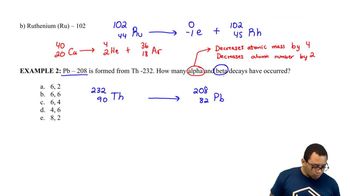Identify the starting radioisotopes needed to balance each of these nuclear reactions:
a. ? + 42He → 11349In
b. ? + 42He → 137N + 10n
 Verified step by step guidance
Verified step by step guidance Verified video answer for a similar problem:
Verified video answer for a similar problem:



 2:06m
2:06mMaster Types of Radiation Concept 1 with a bite sized video explanation from Jules
Start learning